1988 United States presidential election
The 1988 United States presidential election was the 51st quadrennial presidential election. It was held on Tuesday, November 8, 1988. Incumbent Vice President George H. W. Bush, the Republican nominee, defeated Democratic Massachusetts Governor Michael Dukakis. This was the first presidential election since 1940 in which a party won the presidency three consecutive times.
| |||||||||||||||||||||||||||||
538 members of the Electoral College 270 electoral votes needed to win | |||||||||||||||||||||||||||||
|---|---|---|---|---|---|---|---|---|---|---|---|---|---|---|---|---|---|---|---|---|---|---|---|---|---|---|---|---|---|
| Turnout | 50.2%[1] | ||||||||||||||||||||||||||||
| |||||||||||||||||||||||||||||
  Presidential election results map. Red denotes states won by Bush/Quayle and blue denotes those won by Dukakis/Bentsen. Light blue is the electoral vote for Bentsen/Dukakis by a West Virginia faithless elector. Numbers indicate electoral votes cast by each state and the District of Columbia. | |||||||||||||||||||||||||||||
| |||||||||||||||||||||||||||||

Incumbent President Ronald Reagan was ineligible to seek a third term. Bush entered the Republican primaries as the front-runner, defeating U.S. Senator Bob Dole and televangelist Pat Robertson to win the nomination. He selected U.S. Senator Dan Quayle of Indiana as his running mate. Dukakis won the Democratic primaries after Democratic leaders such as Gary Hart and Ted Kennedy withdrew or declined to run. He selected U.S. Senator Lloyd Bentsen of Texas as his running mate.
Running an aggressive campaign, Bush concentrated on the economy and continuing Reagan's policies. He attacked Dukakis as an elitist "Massachusetts liberal", and Dukakis appeared to fail to respond effectively to Bush's criticism. Despite Dukakis's initial lead, Bush pulled ahead in opinion polling conducted in September and won by a substantial margin in both the popular and electoral vote. No candidate since 1988 has managed to equal or surpass Bush's share of the electoral or popular vote. Bush became the first sitting vice president to be elected president since Martin Van Buren in 1836.
Republican Party nomination
Republican candidates
- George H. W. Bush, Vice President [3]
- Bob Dole, U.S. senator from Kansas[4]
- Pat Robertson, televangelist from Virginia[5]
- Jack Kemp, U.S. representative from New York[6]
- Pierre S. du Pont, IV, former governor of Delaware[7]
- Alexander Haig, former Secretary of State, from Pennsylvania[8]
- Ben Fernandez, former Special Ambassador to Paraguay, from California[9]
- Paul Laxalt, former United States Senator from Nevada[10]
- Donald Rumsfeld, former Secretary of Defense, from Illinois[11]
- Harold E. Stassen, former Governor of Minnesota[12]
| George H. W. Bush | Dan Quayle | ||||||||||||||||||||||||||||
|---|---|---|---|---|---|---|---|---|---|---|---|---|---|---|---|---|---|---|---|---|---|---|---|---|---|---|---|---|---|
| for President | for Vice President | ||||||||||||||||||||||||||||
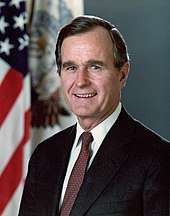 |
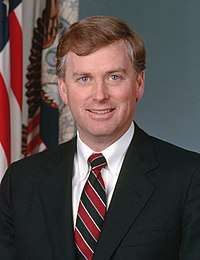 | ||||||||||||||||||||||||||||
| 43rd Vice President of the United States (1981–1989) |
U.S. Senator from Indiana (1981–1989) | ||||||||||||||||||||||||||||
| Campaign | |||||||||||||||||||||||||||||
 | |||||||||||||||||||||||||||||
Vice President George H. W. Bush pledged to continue President Ronald Reagan's policies, but also vowed a "kinder and gentler nation" in an attempt to win over some more moderate voters. The duties delegated to him during Reagan's second term (mostly because of the President's advanced age, Reagan turning 78 just after he left office) gave him an unusually high level of experience for a vice president.
Bush unexpectedly came in third in the Iowa caucus, which he had won in 1980, behind Dole and Robertson. Dole was also leading in the polls of the New Hampshire primary, and the Bush camp responded by running television commercials portraying Dole as a tax raiser, while Governor John H. Sununu campaigned for Bush. Dole did nothing to counter these ads and Bush won, thereby gaining crucial momentum, which he called "Big Mo".[13]
Once the multiple-state primaries such as Super Tuesday began, Bush's organizational strength and fund raising lead were impossible for the other candidates to match, and the nomination was his. The Republican Party convention was held in New Orleans, Louisiana. Bush was nominated unanimously. Bush selected U.S. Senator Dan Quayle of Indiana as his running mate. This marked the most recent presidential election in which a sitting US Senator became a Republican vice presidential nominee.
In his acceptance speech, Bush made the pledge "Read my lips: No new taxes", a comment that would come to haunt him constantly as the economy collapsed in early to mid 1990, which contributed to his loss in the 1992 election.
Democratic Party nomination
The candidates seeking the Democratic party nomination were:
- Michael Dukakis, governor of Massachusetts[14]
- Jesse Jackson, clergyman and civil rights leader from Illinois[15]
- Al Gore, U.S. senator from Tennessee[16]
- Dick Gephardt, U.S. representative from Missouri[17]
- Paul Simon, U.S. senator from Illinois[18]
- Gary Hart, former U.S. senator from Colorado[19]
- Bruce Babbitt, former governor of Arizona[20]
- Joe Biden, U.S. senator from Delaware[21]
- Lyndon LaRouche, economist from Virginia[22]
- James Traficant, U.S. representative from Ohio[23]
- Douglas Applegate, U.S. representative from Ohio[24]
| Michael Dukakis | Lloyd Bentsen | ||||||||||||||||||||||||||||
|---|---|---|---|---|---|---|---|---|---|---|---|---|---|---|---|---|---|---|---|---|---|---|---|---|---|---|---|---|---|
| for President | for Vice President | ||||||||||||||||||||||||||||
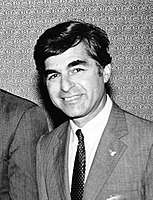 |
 | ||||||||||||||||||||||||||||
| 65th and 67th Governor of Massachusetts (1975–1979, 1983–1991) |
U.S. Senator from Texas (1971–1993) | ||||||||||||||||||||||||||||
| Campaign | |||||||||||||||||||||||||||||
 | |||||||||||||||||||||||||||||
In the 1984 presidential election the Democrats had nominated Walter Mondale, a traditional New Deal-type liberal as their candidate. When Mondale was defeated in a landslide, party leaders became eager to find a new approach to get away from the 1980 and 1984 debacles. After Bush's image was affected by his involvement on the Iran-Contra scandal much more than Reagan's, and after the Democrats won back control of the U.S. Senate in the 1986 congressional elections following an economic downturn, the party's leaders felt optimistic about having a closer race with the GOP in 1988, although probabilities of winning the presidency were still marginal given the climate of prosperity.
One goal of the party was to find a new, fresh candidate who could move beyond the traditional New Deal-Great Society ideas of the past and offer a new image of the Democrats to the public. To this end party leaders tried to recruit the New York Governor Mario Cuomo, to be a candidate. Cuomo had impressed many Democrats with his keynote speech at the 1984 Democratic Convention, and they believed he would be a strong candidate.[25] After Cuomo chose not to run, the Democratic frontrunner for most of 1987 was former Colorado Senator Gary Hart.[26] He had made a strong showing in the 1984 presidential primaries and, after Mondale's defeat, had positioned himself as the moderate centrist many Democrats felt their party would need to win.[27]
But questions and rumors about extramarital affairs and past debts dogged Hart's campaign.[28] Hart had told New York Times reporters who questioned him about these rumors that, if they followed him around, they would "be bored". In a separate investigation, the Miami Herald had received an anonymous tip from a friend of Donna Rice that Rice was involved with Hart. After his affair emerged, the Herald reporters found Hart's quote in a pre-print of The New York Times magazine.[29] After the Herald's findings were publicized, many other media outlets picked up the story and Hart's ratings in the polls plummeted. On May 8, 1987, a week after the Rice story broke, Hart dropped out of the race.[28] His campaign chair, Representative Patricia Schroeder, tested the waters for about four months after Hart's withdrawal, but decided in September 1987 that she would not run.[30] In December 1987, Hart surprised many pundits by resuming his campaign,[31] but the allegations of adultery had delivered a fatal blow to his candidacy, and he did poorly in the primaries before dropping out again.[32]
Senator Ted Kennedy of Massachusetts had been considered a potential candidate, but he ruled himself out of the race in the fall of 1985. Two other politicians mentioned as possible candidates, both from Arkansas, did not join the race: Senator Dale Bumpers and Governor and future President Bill Clinton.
Joe Biden's campaign also ended in controversy after he was accused of plagiarizing a speech by Neil Kinnock, then-leader of the British Labour Party.[33] The Dukakis campaign secretly released a video in which Biden was filmed repeating a Kinnock stump speech with only minor modifications.[34] This ultimately led him to drop out of the race. Dukakis later revealed that his campaign was responsible for leaking the tape, and two members of his staff resigned. The Delaware Supreme Court's Board on Professional Responsibility would later clear Biden of the law school plagiarism charges.[35]
Al Gore, a Senator from Tennessee, also chose to run for the nomination. Turning 40 in 1988, he would have been the youngest man to contest the Presidency on a major party ticket since William Jennings Bryan in 1896, and the youngest president ever if elected, younger than John F. Kennedy at election age and Theodore Roosevelt at age of assumption of office. He eventually became the 45th Vice President of the United States under Bill Clinton, then the Democratic presidential nominee in 2000. Gore was later defeated by George W. Bush, George H.W.'s son, in 2000.
Primaries
After Hart withdrew from the race, no clear frontrunner emerged before the primaries and caucuses began. The Iowa caucus was won by Dick Gephardt, who had been sagging heavily in the polls until, three weeks before the vote, he began campaigning as a populist and his numbers surged. Illinois Senator Paul M. Simon finished a surprising second, and Massachusetts Governor Michael Dukakis finished third. In the New Hampshire primary, Dukakis came in first, Gephardt fell to second, and Simon came in third. In an effort to weaken Gephardt's candidacy, both Dukakis and Gore ran negative television ads against Gephardt. The ads convinced the United Auto Workers, which had endorsed Gephardt, to withdraw their endorsement; this crippled Gephardt, as he relied heavily on the support of labor unions.
In the Super Tuesday races, Dukakis won six primaries, to Gore's five, Jesse Jackson five and Gephardt one, with Gore and Jackson splitting the Southern states. The next week, Simon won Illinois with Jackson finishing second. 1988 remains the race with the most candidates winning primaries since the McGovern reforms of 1971. Jackson captured 6.9 million votes and won 11 contests: seven primaries (Alabama, the District of Columbia, Georgia, Louisiana, Mississippi, Puerto Rico and Virginia) and four caucuses (Delaware, Michigan, South Carolina and Vermont). He also scored March victories in Alaska's caucuses and Texas's local conventions, despite losing the Texas primary. Briefly, after he won 55% of the vote in the Michigan Democratic caucus, he had more pledged delegates than all the other candidates.
Jackson's campaign suffered a significant setback less than two weeks later when he was defeated in the Wisconsin primary by Dukakis. Dukakis's win in New York and then in Pennsylvania effectively ended Jackson's hopes for the nomination.
Democratic Convention
The Democratic Party Convention was held in Atlanta, Georgia from July 18–21. Arkansas Governor Bill Clinton placed Dukakis's name in nomination, but the nominating speech lasted for so long that some delegates began booing to get him to finish, and he received great cheering when he said, "In closing...".[36]
Texas State Treasurer Ann Richards, who was elected the state governor two years later, gave a speech attacking George Bush, including the line "Poor George, he can't help it, he was born with a silver foot in his mouth."
With only Jackson remaining as an active candidate to oppose Dukakis, the tally for president was:
| Presidential ballot | Vice Presidential ballot | ||
|---|---|---|---|
| Michael S. Dukakis | 2,876.25 | Lloyd M. Bentsen | 4,162 |
| Jesse L. Jackson | 1,218.5 | ||
| Richard H. Stallings | 3 | ||
| Joe Biden | 2 | ||
| Richard A. Gephardt | 2 | ||
| Gary W. Hart | 1 | ||
| Lloyd M. Bentsen | 1 |
Jackson's supporters said that since their candidate had finished in second place, he was entitled to the vice-presidential spot. Dukakis disagreed, and instead selected Senator Lloyd Bentsen from Texas. Bentsen's selection led many in the media to dub the ticket the "Boston-Austin" axis, and to compare it to the pairing of John F. Kennedy and Lyndon B. Johnson in the 1960 presidential campaign. Like Dukakis and Bentsen, Kennedy and Johnson were from Massachusetts and Texas respectively.
Other nominations
Libertarian Party
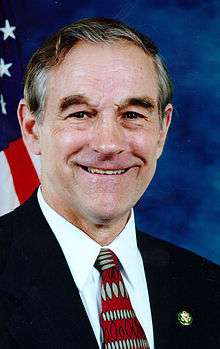
Ron Paul and Andre Marrou formed the ticket for the Libertarian Party. Their campaign called for the adoption of a global policy on military nonintervention, advocated an end to the federal government's involvement with education, and criticized Reagan's "bailout" of the Soviet Union. Paul was a former member of the U.S. House of Representatives, first elected as a Republican from Texas in an April 1976 special election. He protested the War on Drugs in a letter to Drug Czar William Bennett.
New Alliance Party
Lenora Fulani ran for the New Alliance Party, and focused on issues concerning unemployment, healthcare, and homelessness. The party had full ballot access, meaning Fulani and her running mate, Joyce Dattner, were the first women to receive ballot access in all 50 states.[37] Fulani was the first African American to do so.
Socialist Party
Willa Kenoyer and Ron Ehrenreich ran for the Socialist Party, advocating a decentralist government approach with policies determined by the needs of the workers.
Populist Party
David E. Duke stood for the Populist Party. A former leader of the Louisiana Ku Klux Klan, he advocated a mixture of White nationalist and separatist policies with more traditionally conservative positions, such as opposition to most immigration from Latin America and to affirmative action.
General election
Campaign
During the election, the Bush campaign sought to portray Governor Dukakis as an unreasonable "Massachusetts liberal." Dukakis was attacked for such positions as opposing mandatory recitation of the Pledge of Allegiance in schools, and being a "card-carrying member of the ACLU" (a statement Dukakis made himself early in the primary campaign). Dukakis responded by saying that he was a "proud liberal" and that the phrase should not be a bad word in America. Bush, a graduate of Yale University, derided Dukakis for having "foreign-policy views born in Harvard Yard's boutique."[38] New York Times columnist Maureen Dowd asked "Wasn't this a case of the pot calling the kettle elite?" Bush said that, unlike Harvard, Yale's reputation was "so diffuse, there isn't a symbol, I don't think, in the Yale situation, any symbolism in it.... Harvard boutique to me has the connotation of liberalism and elitism," and said Harvard in his remark was intended to represent "a philosophical enclave" and not a statement about class.[39] Columnist Russell Baker opined that "Voters inclined to loathe and fear elite Ivy League schools rarely make fine distinctions between Yale and Harvard. All they know is that both are full of rich, fancy, stuck-up and possibly dangerous intellectuals who never sit down to supper in their undershirt no matter how hot the weather gets."[40]
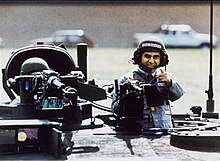
Governor Dukakis attempted to quell criticism that he was ignorant on military matters by staging a photo op in which he rode in an M1 Abrams tank outside a General Dynamics plant in Sterling Heights, Michigan.[41] The move ended up being regarded as a major public relations blunder, with many mocking Dukakis's appearance as he waved to the crowd from the tank. Footage of Dukakis was used by the Bush campaign as evidence he would not make a good commander-in-chief, and the incident remains a commonly cited example of backfired public relations outings.[42][43]

One reason for Bush's choice of running mate, Senator Dan Quayle, was to appeal to a younger generation of Americans identified with the "Reagan Revolution". Quayle's looks were praised by Senator John McCain: "I can't believe a guy that handsome wouldn't have some impact."[44] Quayle was not a seasoned politician, however, and made a number of embarrassing statements. The Dukakis team attacked Quayle's credentials, saying he was "dangerously inexperienced to be first-in-line to the presidency."[45]
During the Vice Presidential debate, Quayle attempted to dispel such allegations by comparing his experience with that of former Senator John F. Kennedy, who had also been a young political rookie when running for the presidency (Kennedy had served fourteen years in Congress to Quayle's twelve). Quayle said, "I have as much experience in the Congress as Jack Kennedy did when he sought the presidency." "Senator, I served with Jack Kennedy. I knew Jack Kennedy," Dukakis's running mate, Lloyd Bentsen, responded. "Jack Kennedy was a friend of mine. Senator, you're no Jack Kennedy."[46]
Quayle responded, "That was really uncalled for, Senator," to which Bentsen said, "You are the one that was making the comparison, Senator, and I'm one who knew him well. And frankly I think you are so far apart in the objectives you choose for your country that I did not think the comparison was well-taken."
Quayle's reaction to Bentsen's comment was played and replayed by the Democrats in subsequent television ads as an announcer intoned, "Quayle: just a heartbeat away." Despite much press about the Kennedy comments, this did not reduce the Bush-Quayle lead in the polls. Quayle had sought to use the debate to criticize Dukakis as too liberal rather than go point for point with the more seasoned Bentsen. Bentsen's attempts to defend Dukakis received little recognition, with greater attention on the Kennedy comparison.
During the course of the campaign, Dukakis fired his deputy field director Donna Brazile after she spread rumors that Bush had an affair with his assistant Jennifer Fitzgerald.[47] The relationship of George H.W. Bush and Jennifer Fitzgerald would be briefly rehashed during the 1992 campaign.[48][49]
Dukakis was badly damaged by the Republicans' campaign commercials, including "Boston Harbor",[50] which attacked the governor's failure to clean up environmental pollution in the harbor, and especially by two commercials -which were accused of being racially charged- ("Revolving Door" and "Weekend Passes"/aka "Willie Horton"[51]) that portrayed him as "soft on crime". Dukakis was a strong supporter of Massachusetts's prison furlough program, which had begun before he was governor. As governor, Dukakis had vetoed a 1976 plan to bar inmates convicted of first-degree murder from the furlough program. In 1986, the program had resulted in the release of convicted murderer Willie Horton, an African American man who committed a rape and assault in Maryland while out on furlough.
A number of false rumors about Dukakis were reported in the media, including the claim by Idaho Republican Senator Steve Symms that Dukakis's wife Kitty had burned an American flag to protest the Vietnam War,[52] as well as the claim that Dukakis himself had been treated for a mental illness.[53]
Voters were split as to who won the first presidential debate.[54] Bush improved in the second debate. Before the second debate, Dukakis had been suffering from the flu and spent much of the day in bed. His performance was generally seen as poor and played to his reputation of being intellectually cold. Reporter Bernard Shaw opened the debate by asking Dukakis whether he would support the death penalty if Kitty Dukakis were raped and murdered; Dukakis said "no" and discussed the statistical ineffectiveness of capital punishment. Some commentators thought the question itself was unfair, in that it injected an overly emotional element into the discussion of a policy issue, but many observers felt Dukakis's answer lacked the normal emotions one would expect of a person talking about a loved one's rape and murder.[55] Tom Brokaw of NBC reported on his October 14 newscast, "The consensus tonight is that Vice President George Bush won last night's debate and made it all the harder for Governor Michael Dukakis to catch and pass him in the 25 days remaining. In all of the Friday morning quarterbacking, there was common agreement that Dukakis failed to seize the debate and make it his night."[56]
Debates
There were two presidential debates and one vice presidential debate during the 1988 general election.[57]
| No. | Date | Host | Location | Panelists | Moderator | Participants | Viewership
(Millions) |
|---|---|---|---|---|---|---|---|
| P1 | Sunday, September 25, 1988 | Wake Forest University | Winston-Salem, North Carolina | John Mashek
Anne Groer |
Jim Lehrer | George H. W. Bush
Michael Dukakis |
65.1[57] |
| VP | Wednesday, October 5, 1988 | Omaha Civic Auditorium | Omaha, Nebraska | Tom Brokaw
Jon Margolis |
Judy Woodruff | Dan Quayle
Lloyd Bentsen |
46.9[57] |
| P2 | Thursday, October 13, 1988 | University of California, Los Angeles | Los Angeles, California | Andrea Mitchell | Bernard Shaw | George H. W. Bush
Michael Dukakis |
67.3[57] |
Polling
| Poll source | Date(s) administered |
Sample size |
Margin of error |
George Bush (R) |
Michael Dukakis (D) |
Other | Undecided |
|---|---|---|---|---|---|---|---|
| NBC News/Wall Street Journal | October 23–26, 1988 | 1,285 LV | ± 46% | 51% | 42% | — | — |
| NBC News/Wall Street Journal | October 14–16, 1988 | 1,378 LV | ± 3% | 55% | 38% | — | — |
| Gallup | September 14–19, 1988 | 1,020 RV | ± 3% | 47% | 42% | — | — |
| ABC News/Washington Post | September 14–19, 1988 | 1,271 LV | ± 3% | 50% | 46% | — | — |
| Wall Street Journal/NBC News | August 20-22, 1988 | 1,762 RV | ± 3% | 44% | 39% | — | — |
| Gallup | July 21–22, 1988 | 948 RV | ± 4% | 38% | 55% | — | — |
| New York Times/CBS News | July 8–10, 1988 | 1,001 RV | ± % | 41% | 47% | — | — |
| Gallup | June 24–26, 1988 | 1,056 RV | ± 3% | 41% | 46% | — | — |
| New York Times/CBS News | May 9–12, 1988 | 1,056 RV | ± % | 39% | 49% | — | — |
Results
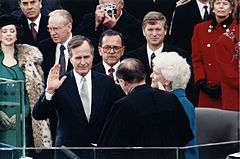
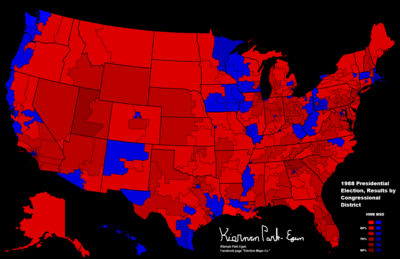
In the November 8 election, Bush won a majority of the popular vote and a lopsided majority (40) of states in the Electoral College.[58]
Bush performed very strongly among suburban voters, perhaps owing to his campaign themes of law and order, punctuated by his criticisms of the Massachusetts furlough program, as well as his "read my lips, no new taxes" pledge. This was a boon in several swing states. In Illinois, Bush won 69% in DuPage County and 63% in Lake County, suburban areas which adjoin Chicago's Cook County. In Pennsylvania, he swept the group of suburban counties that surround Philadelphia, including Bucks, Delaware, Chester, and Montgomery. Bush also won most of the counties in Maryland. New Jersey, known at the time for its many suburban voters and its moderate Republicanism, went easily for Bush.
In contrast to the suburbs, Bush's percentage of votes in rural counties was significantly below the support they gave Reagan in 1980 and 1984. In Illinois, Bush lost a number of downstate counties that previously went for Reagan. He lost the state of Iowa by a surprisingly wide margin, losing counties all across the state even in traditionally Republican areas. The rural state of West Virginia narrowly flipped back into the Democratic column. Bush also performed weaker in the northern counties of Missouri, narrowly winning that state. In three typically solid Republican states, Kansas, South Dakota, and Montana, the vote was much closer than usual. The farm states had fared poorly since the recession of the mid-to-late 1970s and early 1980s, and Dukakis was the beneficiary of these agricultural problems.[59][60] Probably as a result of this, 1988 is the only election since 1916 when Blaine County, Montana supported a losing presidential candidate,[61] the only occasion since 1948 when Sargent County, North Dakota did not support the winning candidate,[62] and the last occasion as of 2016 when neighbouring Marshall County, South Dakota did not predict the winner.[63]
Bush's greatest area of strength was in the South, where he won most states by wide margins. He also performed very well in the Northeast, winning Maine (where he had a residence), New Hampshire (a Republican stronghold), Vermont (a bastion of liberal and moderate Republicanism), and Connecticut (where his father Prescott Bush had been a senator). Bush lost New York by a margin of just over 4%. He also won Delaware, a swing state at the time. Despite the presence of Lloyd Bentsen on the Democratic ticket (and other Texans getting prominent roles at the Democratic convention), Bush won Texas by 12 points. He lost the Pacific northwestern states but kept California in the Republican column for the sixth straight time, however the margin was rather narrow as he won it by 3.57% a sign of the state moving more to the left. This was, to date, the last presidential election in which a Republican candidate won California, Connecticut, Delaware, Illinois, Maryland, New Jersey and Vermont.
Bush carried other states or congressional districts that have rarely voted for a Republican since: Michigan and Pennsylvania would not vote Republican again until 2016, as did Maine's 2nd congressional district. New Mexico wouldn't vote Republican again until 2004, and Arkansas, Kentucky, Louisiana, Missouri, Nevada, New Hampshire, Ohio, and Tennessee wouldn't vote Republican again until 2000. This election was the last time that a Republican was elected president without winning West Virginia. Neither his victory percentage (53.4%) nor his total electoral votes (426) have been surpassed in any subsequent presidential election. Barack Obama came closest in the former with 52.9% in 2008, and Bill Clinton closest in the latter with 379 electoral votes in 1996. Bush was the last candidate to receive an absolute majority of the popular vote until his son George W. Bush's 2004 election. This was the last election to date in which a Republican presidential nominee won a majority of Northern electoral votes, and was also the first election since 1960 when the state of Wisconsin backed the losing candidate as well. This was also the last election until 2016 in which Wisconsin did not vote the same as Illinois. This is the first time a Republican won presidential election without carrying Iowa (the only other time being the 2000 election), the second time a Republican was elected without carrying Oregon (the first was in the 1868 election) and the last time a Republican carried any of the contiguous states on the West Coast. The two most closely contested states were Washington, where Dukakis won by less than 2% of the vote, and Illinois, which Bush won by slightly more than 2%.
Bush's campaign was also the last time to date that a Republican presidential campaign won a majority or plurality among women voters.[64]
Statistics
| Presidential candidate | Party | Home state | Popular vote | Electoral vote |
Running mate | |||
|---|---|---|---|---|---|---|---|---|
| Count | Percentage | Vice-presidential candidate | Home state | Electoral vote | ||||
| George Herbert Walker Bush | Republican | Texas | 48,886,597 | 53.37% | 426 | James Danforth Quayle | Indiana | 426 |
| Michael Stanley Dukakis | Democratic | Massachusetts | 41,809,476 | 45.65% | 111 | Lloyd Millard Bentsen, Jr. | Texas | 111 |
| Lloyd Millard Bentsen, Jr. | Democratic | Texas | —(a) | —(a) | 1 | Michael S. Dukakis | Massachusetts | 1 |
| Ronald Ernest Paul | Libertarian | Texas | 431,750 | 0.47% | 0 | Andre Verne Marrou | Alaska | 0 |
| Lenora Branch Fulani | New Alliance | Pennsylvania | 217,221 | 0.24% | 0 | —(b) | — | 0 |
| Other | 249,642 | 0.27% | — | Other | — | |||
| Total | 91,594,686 | 100% | 538 | 538 | ||||
| Needed to win | 270 | 270 | ||||||
Source (popular vote): "Electoral College Box Scores 1789–1996". National Archives and Records Administration. Retrieved August 7, 2005., Leip, David. "1988 Presidential Election Results". Dave Leip's Atlas of U.S. Presidential Elections. Retrieved August 7, 2005.
Source (electoral vote): "Electoral College Box Scores 1789–1996". National Archives and Records Administration. Retrieved August 7, 2005.
(a) West Virginia faithless elector Margarette Leach voted for Bentsen as president and Dukakis as vice president in order to make a statement against the U.S. Electoral College.
(b) Fulani's running mate varied from state to state.[65] Among the six vice presidential candidates were Joyce Dattner, Harold Moore,[66] and Wynonia Burke.[67]
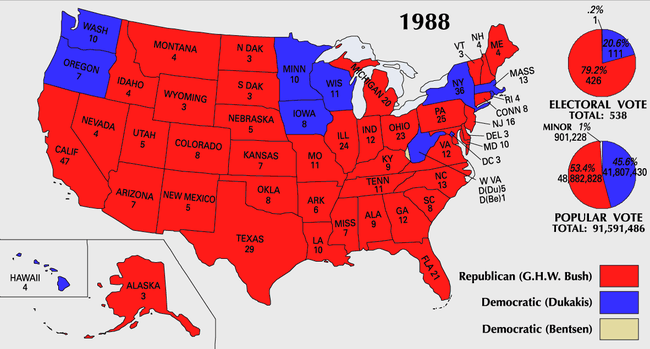
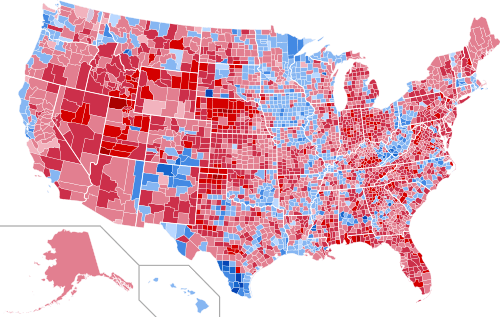 Results by county, shaded according to winning candidate's percentage of the vote
Results by county, shaded according to winning candidate's percentage of the vote
Results by state
Source:[68]
| States/districts won by Bush/Quayle |
| States/districts won by Dukakis/Bentsen |
| George H.W. Bush Republican |
Michael Dukakis Democratic |
Ron Paul Libertarian |
Lenora Fulani New Alliance |
Margin | State Total | ||||||||||||
|---|---|---|---|---|---|---|---|---|---|---|---|---|---|---|---|---|---|
| State | electoral votes |
# | % | electoral votes |
# | % | electoral votes |
# | % | electoral votes |
# | % | electoral votes |
# | % | # | |
| Alabama | 9 | 815,576 | 59.17 | 9 | 549,506 | 39.86 | – | 8,460 | 0.61 | – | 3,311 | 0.24 | – | 266,070 | 19.30 | 1,378,476 | AL |
| Alaska | 3 | 119,251 | 59.59 | 3 | 72,584 | 36.27 | – | 5,484 | 2.74 | – | 1,024 | 0.51 | – | 46,667 | 23.32 | 200,116 | AK |
| Arizona | 7 | 702,541 | 59.95 | 7 | 454,029 | 38.74 | – | 13,351 | 1.14 | – | 1,662 | 0.14 | – | 248,512 | 21.21 | 1,171,873 | AZ |
| Arkansas | 6 | 466,578 | 56.37 | 6 | 349,237 | 42.19 | – | 3,297 | 0.40 | – | 2,161 | 0.26 | – | 117,341 | 14.18 | 827,738 | AR |
| California | 47 | 5,054,917 | 51.13 | 47 | 4,702,233 | 47.56 | – | 70,105 | 0.71 | – | 31,180 | 0.32 | – | 352,684 | 3.57 | 9,887,064 | CA |
| Colorado | 8 | 728,177 | 53.06 | 8 | 621,453 | 45.28 | – | 15,482 | 1.13 | – | 2,539 | 0.19 | – | 106,724 | 7.78 | 1,372,394 | CO |
| Connecticut | 8 | 750,241 | 51.98 | 8 | 676,584 | 46.87 | – | 14,071 | 0.97 | – | 2,491 | 0.17 | – | 73,657 | 5.10 | 1,443,394 | CT |
| Delaware | 3 | 139,639 | 55.88 | 3 | 108,647 | 43.48 | – | 1,162 | 0.47 | – | 443 | 0.18 | – | 30,992 | 12.40 | 249,891 | DE |
| D.C. | 3 | 27,590 | 14.30 | – | 159,407 | 82.65 | 3 | 554 | 0.29 | – | 2,901 | 1.50 | – | −131,817 | −68.34 | 192,877 | DC |
| Florida | 21 | 2,618,885 | 60.87 | 21 | 1,656,701 | 38.51 | – | 19,796 | 0.46 | – | 6,655 | 0.15 | – | 962,184 | 22.36 | 4,302,313 | FL |
| Georgia | 12 | 1,081,331 | 59.75 | 12 | 714,792 | 39.50 | – | 8,435 | 0.47 | – | 5,099 | 0.28 | – | 366,539 | 20.25 | 1,809,672 | GA |
| Hawaii | 4 | 158,625 | 44.75 | – | 192,364 | 54.27 | 4 | 1,999 | 0.56 | – | 1,003 | 0.28 | – | −33,739 | −9.52 | 354,461 | HI |
| Idaho | 4 | 253,881 | 62.08 | 4 | 147,272 | 36.01 | – | 5,313 | 1.30 | – | 2,502 | 0.61 | – | 106,609 | 26.07 | 408,968 | ID |
| Illinois | 24 | 2,310,939 | 50.69 | 24 | 2,215,940 | 48.60 | – | 14,944 | 0.33 | – | 10,276 | 0.23 | – | 94,999 | 2.08 | 4,559,120 | IL |
| Indiana | 12 | 1,297,763 | 59.84 | 12 | 860,643 | 39.69 | – | – | – | – | 10,215 | 0.47 | – | 437,120 | 20.16 | 2,168,621 | IN |
| Iowa | 8 | 545,355 | 44.50 | – | 670,557 | 54.71 | 8 | 2,494 | 0.20 | – | 540 | 0.04 | – | −125,202 | −10.22 | 1,225,614 | IA |
| Kansas | 7 | 554,049 | 55.79 | 7 | 422,636 | 42.56 | – | 12,553 | 1.26 | – | 3,806 | 0.38 | – | 131,413 | 13.23 | 993,044 | KS |
| Kentucky | 9 | 734,281 | 55.52 | 9 | 580,368 | 43.88 | – | 2,118 | 0.16 | – | 1,256 | 0.09 | – | 153,913 | 11.64 | 1,322,517 | KY |
| Louisiana | 10 | 883,702 | 54.27 | 10 | 734,281 | 44.06 | – | 4,115 | 0.25 | – | 2,355 | 0.14 | – | 166,242 | 10.21 | 1,628,202 | LA |
| Maine | 4 | 307,131 | 55.34 | 4 | 243,569 | 43.88 | – | 2,700 | 0.49 | – | 1,405 | 0.25 | – | 63,562 | 11.45 | 555,035 | ME |
| Maryland | 10 | 876,167 | 51.11 | 10 | 826,304 | 48.20 | – | 6,748 | 0.39 | – | 5,115 | 0.30 | – | 49,863 | 2.91 | 1,714,358 | MD |
| Massachusetts | 13 | 1,194,644 | 45.38 | – | 1,401,406 | 53.23 | 13 | 24,251 | 0.92 | – | 9,561 | 0.36 | – | −206,762 | −7.85 | 2,632,805 | MA |
| Michigan | 20 | 1,965,486 | 53.57 | 20 | 1,675,783 | 45.67 | – | 18,336 | 0.50 | – | 2,513 | 0.07 | – | 289,703 | 7.90 | 3,669,163 | MI |
| Minnesota | 10 | 962,337 | 45.90 | – | 1,109,471 | 52.91 | 10 | 5,109 | 0.24 | – | 1,734 | 0.08 | – | −147,134 | −7.02 | 2,096,790 | MN |
| Mississippi | 7 | 557,890 | 59.89 | 7 | 363,921 | 39.07 | – | 3,329 | 0.36 | – | 2,155 | 0.23 | – | 193,969 | 20.82 | 931,527 | MS |
| Missouri | 11 | 1,084,953 | 51.83 | 11 | 1,001,619 | 47.85 | – | – | – | – | 6,656 | 0.32 | – | 83,334 | 3.98 | 2,093,228 | MO |
| Montana | 4 | 190,412 | 52.07 | 4 | 168,936 | 46.20 | – | 5,047 | 1.38 | – | 1,279 | 0.35 | – | 21,476 | 5.87 | 365,674 | MT |
| Nebraska | 5 | 398,447 | 60.15 | 5 | 259,646 | 39.20 | – | 2,536 | 0.38 | – | 1,743 | 0.26 | – | 138,801 | 20.96 | 662,372 | NE |
| Nevada | 4 | 206,040 | 58.86 | 4 | 132,738 | 37.92 | – | 3,520 | 1.01 | – | 835 | 0.24 | – | 73,302 | 20.94 | 350,067 | NV |
| New Hampshire | 4 | 281,537 | 62.49 | 4 | 163,696 | 36.33 | – | 4,502 | 1.00 | – | 790 | 0.18 | – | 117,841 | 26.16 | 450,525 | NH |
| New Jersey | 16 | 1,743,192 | 56.24 | 16 | 1,320,352 | 42.60 | – | 8,421 | 0.27 | – | 5,139 | 0.17 | – | 422,840 | 13.64 | 3,099,553 | NJ |
| New Mexico | 5 | 270,341 | 51.86 | 5 | 244,497 | 46.90 | – | 3,268 | 0.63 | – | 2,237 | 0.43 | – | 25,844 | 4.96 | 521,287 | NM |
| New York | 36 | 3,081,871 | 47.52 | – | 3,347,882 | 51.62 | 36 | 12,109 | 0.19 | – | 15,845 | 0.24 | – | −266,011 | −4.10 | 6,485,683 | NY |
| North Carolina | 13 | 1,237,258 | 57.97 | 13 | 890,167 | 41.71 | – | 1,263 | 0.06 | – | 5,682 | 0.27 | – | 347,091 | 16.26 | 2,134,370 | NC |
| North Dakota | 3 | 166,559 | 56.03 | 3 | 127,739 | 42.97 | – | 1,315 | 0.44 | – | 396 | 0.13 | – | 38,820 | 13.06 | 297,261 | ND |
| Ohio | 23 | 2,416,549 | 55.00 | 23 | 1,939,629 | 44.15 | – | 11,989 | 0.27 | – | 12,017 | 0.27 | – | 476,920 | 10.85 | 4,393,699 | OH |
| Oklahoma | 8 | 678,367 | 57.93 | 8 | 483,423 | 41.28 | – | 6,261 | 0.53 | – | 2,985 | 0.25 | – | 194,944 | 16.65 | 1,171,036 | OK |
| Oregon | 7 | 560,126 | 46.61 | – | 616,206 | 51.28 | 7 | 14,811 | 1.23 | – | 6,487 | 0.54 | – | −56,080 | −4.67 | 1,201,694 | OR |
| Pennsylvania | 25 | 2,300,087 | 50.70 | 25 | 2,194,944 | 48.39 | – | 12,051 | 0.27 | – | 4,379 | 0.10 | – | 105,143 | 2.32 | 4,536,251 | PA |
| Rhode Island | 4 | 177,761 | 43.93 | – | 225,123 | 55.64 | 4 | 825 | 0.20 | – | 280 | 0.07 | – | −47,362 | −11.71 | 404,620 | RI |
| South Carolina | 8 | 606,443 | 61.50 | 8 | 370,554 | 37.58 | – | 4,935 | 0.50 | – | 4,077 | 0.41 | – | 235,889 | 23.92 | 986,009 | SC |
| South Dakota | 3 | 165,415 | 52.85 | 3 | 145,560 | 46.51 | – | 1,060 | 0.34 | – | 730 | 0.23 | – | 19,855 | 6.34 | 312,991 | SD |
| Tennessee | 11 | 947,233 | 57.89 | 11 | 679,794 | 41.55 | – | 2,041 | 0.12 | – | 1,334 | 0.08 | – | 267,439 | 16.34 | 1,636,250 | TN |
| Texas | 29 | 3,036,829 | 55.95 | 29 | 2,352,748 | 43.35 | – | 30,355 | 0.56 | – | 7,208 | 0.13 | – | 684,081 | 12.60 | 5,427,410 | TX |
| Utah | 5 | 428,442 | 66.22 | 5 | 207,343 | 32.05 | – | 7,473 | 1.16 | – | 455 | 0.07 | – | 221,099 | 34.17 | 647,008 | UT |
| Vermont | 3 | 124,331 | 51.10 | 3 | 115,775 | 47.58 | – | 1,003 | 0.41 | – | 205 | 0.08 | – | 8,556 | 3.52 | 243,333 | VT |
| Virginia | 12 | 1,309,162 | 59.74 | 12 | 859,799 | 39.23 | – | 8,336 | 0.38 | – | 14,312 | 0.65 | – | 449,363 | 20.50 | 2,191,609 | VA |
| Washington | 10 | 903,835 | 48.46 | – | 933,516 | 50.05 | 10 | 17,240 | 0.92 | – | 3,520 | 0.19 | – | −29,681 | −1.59 | 1,865,253 | WA |
| West Virginia | 6 | 310,065 | 47.46 | – | 341,016 | 52.20 | 5 | – | – | – | 2,230 | 0.34 | – | −30,951 | −4.74 | 653,311 | WV |
| Wisconsin | 11 | 1,047,499 | 47.80 | – | 1,126,794 | 51.41 | 11 | 5,157 | 0.24 | – | 1,953 | 0.09 | – | −79,295 | −3.62 | 2,191,608 | WI |
| Wyoming | 3 | 106,867 | 60.53 | 3 | 67,113 | 38.01 | – | 2,026 | 1.15 | – | 545 | 0.31 | – | 39,754 | 22.52 | 176,551 | WY |
| TOTALS: | 538 | 48,886,597 | 53.37 | 426 | 41,809,476 | 45.65 | 111 | 431,750 | 0.47 | – | 217,221 | 0.24 | – | 7,077,121 | 7.73 | 91,594,686 | US |
Close states
States with margin of victory less than 5% (195 electoral votes):
- Washington, 1.59%
- Illinois, 2.09%
- Pennsylvania, 2.31%
- Maryland, 2.91%
- Vermont, 3.52%
- California, 3.57%
- Wisconsin, 3.61%
- Missouri, 3.98%
- New York, 4.10%
- Oregon, 4.67%
- West Virginia, 4.74%
- New Mexico, 4.96%
States with margin of victory between 5% and 10% (70 electoral votes):
- Connecticut, 5.11%
- Montana, 5.87%
- South Dakota, 6.34%
- Minnesota, 7.01%
- Colorado, 7.78%
- Massachusetts, 7.85%
- Michigan, 7.90% (tipping point state)
- Hawaii, 9.52%
Voter demographics
| The 1988 presidential vote by demographic subgroup | ||||||
|---|---|---|---|---|---|---|
| Demographic subgroup | Dukakis | Bush | % of total vote | |||
| Total vote | 46 | 53 | 100 | |||
| Ideology | ||||||
| Liberals | 82 | 18 | 20 | |||
| Moderates | 51 | 49 | 45 | |||
| Conservatives | 19 | 81 | 33 | |||
| Party | ||||||
| Democrats | 83 | 17 | 37 | |||
| Republicans | 8 | 92 | 35 | |||
| Independents | 43 | 57 | 26 | |||
| Gender | ||||||
| Men | 42 | 58 | 48 | |||
| Women | 49 | 51 | 52 | |||
| Race | ||||||
| White | 40 | 60 | 85 | |||
| Black | 89 | 11 | 10 | |||
| Hispanic | 70 | 30 | 3 | |||
| Age | ||||||
| 18–29 years old | 47 | 53 | 20 | |||
| 30–44 years old | 46 | 54 | 35 | |||
| 45–59 years old | 42 | 58 | 22 | |||
| 60 and older | 49 | 51 | 22 | |||
| Family income | ||||||
| Under $12,500 | 63 | 37 | 12 | |||
| $12,500–25,000 | 43 | 57 | 20 | |||
| $25,000–35,000 | 43 | 57 | 20 | |||
| $35,000–50,000 | 43 | 57 | 20 | |||
| $50,000–100,000 | 39 | 61 | 19 | |||
| Over $100,000 | 33 | 67 | 5 | |||
| Region | ||||||
| East | 49 | 51 | 25 | |||
| Midwest | 47 | 53 | 28 | |||
| South | 41 | 59 | 28 | |||
| West | 47 | 53 | 19 | |||
| Union households | ||||||
| Union | 57 | 43 | 25 | |||
Source: CBS News and The New York Times exit poll from the Roper Center for Public Opinion Research (11,645 surveyed)[69]
See also
References
- "Dave Leip's Atlas of U.S. Presidential Elections". uselectionatlas.org. Retrieved October 21, 2012.
- A faithless Democratic elector voted for Bentsen for president and Dukakis for vice president
- "Bush Announces Quest for Presidency". Sarasota Herald-Tribune. October 13, 1987. Retrieved July 12, 2011.
- "Dole announces presidential hopes in hometown talk". Star-News. November 10, 1987. Retrieved July 12, 2011.
- "Robertson announces". Ellensburg Daily Record. October 2, 1987. Retrieved July 12, 2011.
- "Kemp announces bid for nomination". The Bryan Times. April 6, 1987. Retrieved July 12, 2011.
- Dionne Jr., E. J. (September 17, 1986). "DU PONT ENTERS THE G.O.P. RACE FOR PRESIDENT". The New York Times. p. 1. Retrieved July 12, 2011.
- "Haig announces his bid for presidency". Pittsburgh Post-Gazette. March 24, 1987. Retrieved July 12, 2011.
- Wallace, David (August 6, 1987). "GOP PRESIDENTIAL CANDIDATE MAKES STOP IN SOUTH FLORIDA". Sun Sentinel. Retrieved July 12, 2011.
- Witt, Evans (April 29, 1987). "Laxalt announces bid for presidency, says 'there is unfinished work to do'". Gettysburg Times. Retrieved July 12, 2011.
- "Rumsfeld enters race". The Telegraph-Herald. January 20, 1987. Retrieved July 12, 2011.
- "Stassen announces his candidacy". The Milwaukee Journal. September 22, 1987. Retrieved July 12, 2011.
- Dillin, John (February 18, 1988). "Even with win, Bush seen to be vulnerable". Christian Science Monitor. p. 1.
- "Dukakis announces bid for presidential nomination". The Milwaukee Sentinel. April 30, 1987. Retrieved July 11, 2011.
- Mattiace, Peter (September 8, 1987). "Jesse Jackson announces plan to seek nomination". Gettysburg Times. Retrieved July 11, 2011.
- "Sen. Gore announces presidential aspiration". Bangor Daily News. April 12, 1987. Retrieved July 11, 2011.
- "Gephardt Announces Bid For White House". The Dispatch. February 23, 1987. Retrieved July 11, 2011.
- "Sen. Simon announces candidacy". The Lewiston Daily Sun. April 10, 1987. Retrieved July 11, 2011.
- "Gary Hart announces he will seek the presidency in 1988". The Fort Scott Tribune. April 13, 1987. Retrieved July 11, 2011.
- Gailey, Phil (January 8, 1987). "BABBITT OF ARIZONA FIRST DEMOCRAT TO FORM KEY PRESIDENTIAL GROUP". The New York Times. p. 24. Retrieved July 11, 2011.
- "Sen. Biden announces candidacy". The Milwaukee Journal. June 9, 1987. Retrieved July 11, 2011.
- "LaRouche announces candidacy". Eugene Register-Guard. January 27, 1987. Retrieved July 11, 2011.
- Wilkinson, D.A. (December 4, 1987). "Traficant hat tossed into ring". The Vindicator. Retrieved July 11, 2011.
- "Applegate To Run As Favorite Son". Portsmouth Daily Times. November 24, 1987. Retrieved July 11, 2011.
- Steve Neal for the Chicago Tribune. April 26, 1985. Democrats Think They See A Better Horse For '88 Race
- John Dillin for The Christian Science Monitor. February 23, 1987 Cuomo's 'no' opens door for dark horses
- E. J. Dionne Jr. (May 3, 1987). "Gary Hart The Elusive Front-Runner". The New York Times, pg. SM28.
- Johnston, David; King, Wayne; Nordheimer, Jon (May 9, 1987). "Courting Danger: The Fall Of Gary Hart". The New York Times.
- "The Gary Hart Story: How It Happened". The Miami Herald. May 10, 1987.
- Warren Weaver, Jr. for The New York Times. September 29, 1987 Schroeder, Assailing 'the System,' Decides Not to Run for President
- Bob Drogin for the Los Angeles Times. December 16, 1987 Hart Back in Race for President : Political World Stunned, Gives Him Little Chance
- Associated Press, in the Los Angeles Times. March 13, 1988 Quits Campaign : 'The People 'Have Decided,' Hart Declares
- Dowd, Maureen (September 12, 1987). "Biden's Debate Finale: An Echo From Abroad". The New York Times.
- Washington Post: Joseph Biden's Plagiarism; Michael Dukakis's 'Attack Video' – 1988. 1988.
- "Professional Board Clears Biden In Two Allegations of Plagiarism". The New York Times. May 29, 1989. p. 29.
- Oates, Marylouise (July 22, 1988). "It Was the Speech That Ate Atlanta". Los Angeles Times. Retrieved July 28, 2013.
- Lenora Fulani bio Archived February 7, 2006, at the Wayback Machine, Speakers Platform. Retrieved February 20, 2006
- Hoffman, David (June 10, 1988). "Bush Attacks Dukakis As Tax-Raising Liberal; Candidate Uses Spirited Speech To Draw His Battle Lines". Washington Post.
- Dowd, Maureen (June 11, 1988). "Bush Traces How Yale Differs From Harvard". The New York Times. p. 10.
- Baker, Russell (June 15, 1988). "The Ivy Hayseed". The New York Times. p. A31.
- Bradlee, Ben, Jr.; Fred Kaplan (September 14, 1988). "Dukakis spells out Soviet policy". The Boston Globe.
- Safire, William (September 15, 1988). "Rat-Tat-Tatting". The New York Times. p. A35.
- Dowd, Maureen (September 17, 1988). "Bush Talks of Lasers and Bombers". The New York Times. p. 8.
- Mapes, Jeff (August 17, 1988). "Bush taps Quayle for VP". The Oregonian. p. A01.
- Toner, Robin (October 7, 1988). "Quayle Reflects Badly on Bush, Dukakis Asserts". The New York Times. p. B6.
- "You're No Jack Kennedy Video". The History Channel. A&E Television Networks. Retrieved February 13, 2014.
- Sanders, Joshunda (July 4, 2004). "State's Dems still hope for a bit of suspense / A contested primary is viewed as a plus for party". The San Francisco Chronicle.
- Conason, Joe (July/August 1992). "Reason No. 1 Not To Vote For George Bush: He Cheats on His Wife." Spy magazine.
- Kurtz, Howard (August 12, 1992). "Bush Angrily Denounces Report of Extramarital Affair as 'a Lie'". Washington Post.
- "Commercials - 1988 - Harbor". Livingroomcandidate.org. Retrieved April 5, 2015.
- "Commercials - 1988 - Willie Horton". Livingroomcandidate.org. Retrieved April 5, 2015.
- "Kitty Dukakis denies flag burning protest". The Bulletin. Bend, OR. August 26, 1988. Retrieved May 28, 2012.
- Lauter, David (August 4, 1988). "Reagan Remark Spurs Dukakis Health Report". Los Angeles Times. Retrieved July 28, 2013.
- After The Debate; Round One Undecisive Dionne, E.J. New York Times. 27 September 1988.
- Hirshson, Paul (October 19, 1988). "Editors on Dukakis: Down, but not out". The Boston Globe. p. 29. Archived from the original on October 8, 2016.
- Death Penalty, Dan Quayle Are Subjects of Bush-Dukakis Debate NBC Nightly News. 14 October 1988. Retrieved 25 August 2016.
- "CPD: 1988 Debates". www.debates.org. Retrieved January 8, 2019.
- Leip, David (2012). "1988 Presidential General Election Results". Us Elections Atlas. Retrieved October 12, 2016.
- Piliawsky, Monte (1989). "Racial Politics in the 1988 Presidential Election". The Black Scholar. 20 (1): 30–37. doi:10.1080/00064246.1989.11412915. ISSN 0006-4246. JSTOR 41068311.
- Cohn, Peter; Cohn, Peter (April 9, 2019). "This Iowa farmer has his finger on the 2020 pulse". Retrieved January 7, 2020.
- The Political Graveyard; Blaine County, Montana
- The Political Graveyard; Sargent County, North Dakota
- The Political Graveyard; Marshall County, South Dakota
- "Election Polls -- Presidential Vote by Groups". Gallup.com. Archived from the original on May 3, 2016. Retrieved May 1, 2016.
- Athitakis, Mark (August 11, 1999). "Booty Call". SF Weekly. Village Voice Media. Retrieved March 21, 2006.
- Fulani, Lenora (1992). The Making of a Fringe Candidate. p. 127. ISBN 0-9628621-3-4.
- "Political Party History in Alaska". Internet Archive copy of official website of Alaska Division of Elections. 2003. Archived from the original on July 1, 2004. Retrieved March 24, 2006.
- "1988 Presidential General Election Data – National". Retrieved February 7, 2013.
- "How Groups Voted in 1988". ropercenter.cornell.edu. Retrieved February 1, 2018.
Further reading
- Alexander, Herbert E. Financing the 1988 election (1991)
- de la Garza, Rodolfo O., ed. From Rhetoric to Reality: Latino Politics in the 1988 Elections (1992)
- Germond, Jack W., and Jules Witcover. Whose Broad Stripes and Bright Stars? (1989), narrative by two famous reporters
- Gopoian, J. David (1993). "Images and issues in the 1988 presidential election". Journal of Politics. 55 (1): 151–66. doi:10.2307/2132233. JSTOR 2132233.
- Guth, James L., and John C. Green, eds. The Bible and the Ballot Box: Religion and Politics in the 1988 Election. (1991)
- Lemert, James B.; Elliott, William R.; Bernstein, James M.; Rosenberg, William L.; Nestvold, Karl J. (1991). News Verdicts, the Debates, and Presidential Campaigns. New York: Praeger. ISBN 0-275-93758-5.
- Moreland, Laurence W.; Steed, Robert P.; Baker, Tod A. (1991). The 1988 Presidential Election in the South: Continuity Amidst Change in Southern Party Politics. New York: Praeger. ISBN 0-275-93145-5.
- Runkel, David R. (1989). Campaign for President: The Managers Look at '88. Dover: Auburn House. ISBN 0-86569-194-0.
- Stempel, Guido H. III; Windhauser, John W. (1991). The Media in the 1984 and 1988 Presidential Campaigns. New York: Greenwood Press. ISBN 0-313-26527-5.
External links
- United States presidential election of 1988 at the Encyclopædia Britannica
- 1988 popular vote by counties
- 1988 popular vote by state
- 1988 popular vote by states (with bar graphs)
- Campaign commercials from the 1988 election
- How close was the 1988 election? at the Wayback Machine (archived August 25, 2012)—Michael Sheppard, Massachusetts Institute of Technology (archived)
- Senator Paul Simon Papers at Southern Illinois University Carbondale
- Booknotes interview with Jack Germond and Jules Witcover on Whose Broad Stripes and Bright Stars? The Trivial Pursuit of the Presidency 1988, August 27, 1989.
- Booknotes interview with Arthur Grace on Choose Me: Portraits of a Presidential Race, December 10, 1989.
- Booknotes interview with Paul Taylor on See How They Run: Electing the President in an Age of Mediaocracy, November 4, 1990.
- Booknotes interview with Richard Ben Cramer on What It Takes: The Way to the White House, July 26, 1992
- Election of 1988 in Counting the Votes
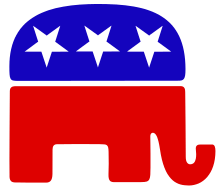
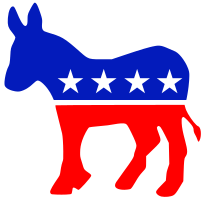
.jpg)
